Dissertation: Dental Clinics, Service Coverage in Karnataka, India
VerifiedAdded on 2023/01/13
|37
|16875
|56
Dissertation
AI Summary
This dissertation investigates the quality and efficiency of dental clinics in Karnataka, India, with the goal of increasing dental service coverage. The introduction outlines the background, aim, objectives, and research questions, emphasizing the importance of dental hygiene and the challenges faced, such as high costs and limited access. The literature review explores existing research, focusing on the problem statement, the need for quality and efficiency in dental care, and the impact of factors like cost and accessibility. The methodology section will detail the research approach. The findings, analysis, and discussion will present and analyze collected data. The conclusion and recommendations will summarize the findings and suggest strategies to improve dental service coverage. The study highlights the need for cost-effective solutions, the impact of private sector dominance, and the importance of addressing barriers to dental care to improve public health outcomes.

Dissertation
Paraphrase This Document
Need a fresh take? Get an instant paraphrase of this document with our AI Paraphraser
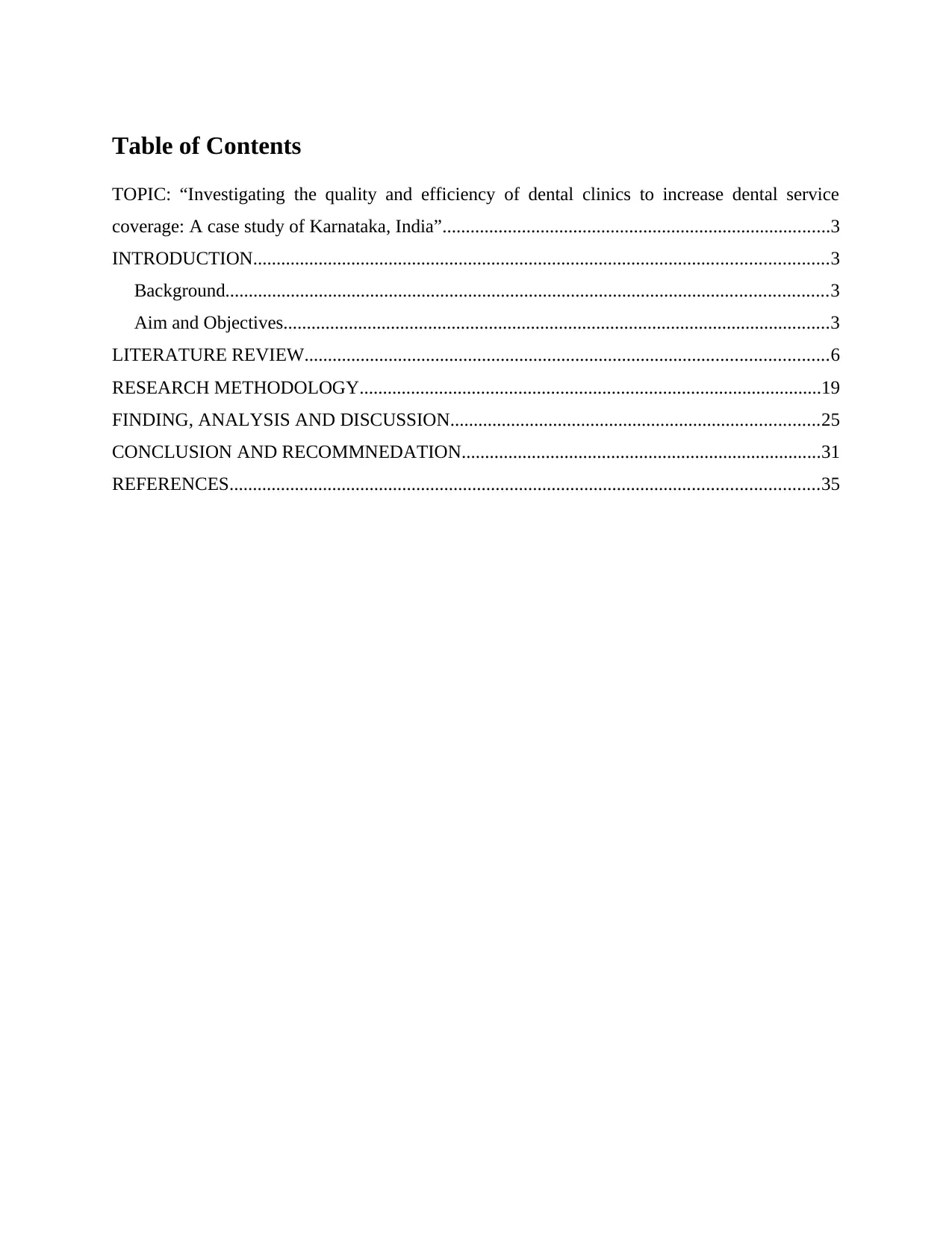
Table of Contents
TOPIC: “Investigating the quality and efficiency of dental clinics to increase dental service
coverage: A case study of Karnataka, India”...................................................................................3
INTRODUCTION...........................................................................................................................3
Background.................................................................................................................................3
Aim and Objectives.....................................................................................................................3
LITERATURE REVIEW................................................................................................................6
RESEARCH METHODOLOGY...................................................................................................19
FINDING, ANALYSIS AND DISCUSSION...............................................................................25
CONCLUSION AND RECOMMNEDATION.............................................................................31
REFERENCES..............................................................................................................................35
TOPIC: “Investigating the quality and efficiency of dental clinics to increase dental service
coverage: A case study of Karnataka, India”...................................................................................3
INTRODUCTION...........................................................................................................................3
Background.................................................................................................................................3
Aim and Objectives.....................................................................................................................3
LITERATURE REVIEW................................................................................................................6
RESEARCH METHODOLOGY...................................................................................................19
FINDING, ANALYSIS AND DISCUSSION...............................................................................25
CONCLUSION AND RECOMMNEDATION.............................................................................31
REFERENCES..............................................................................................................................35
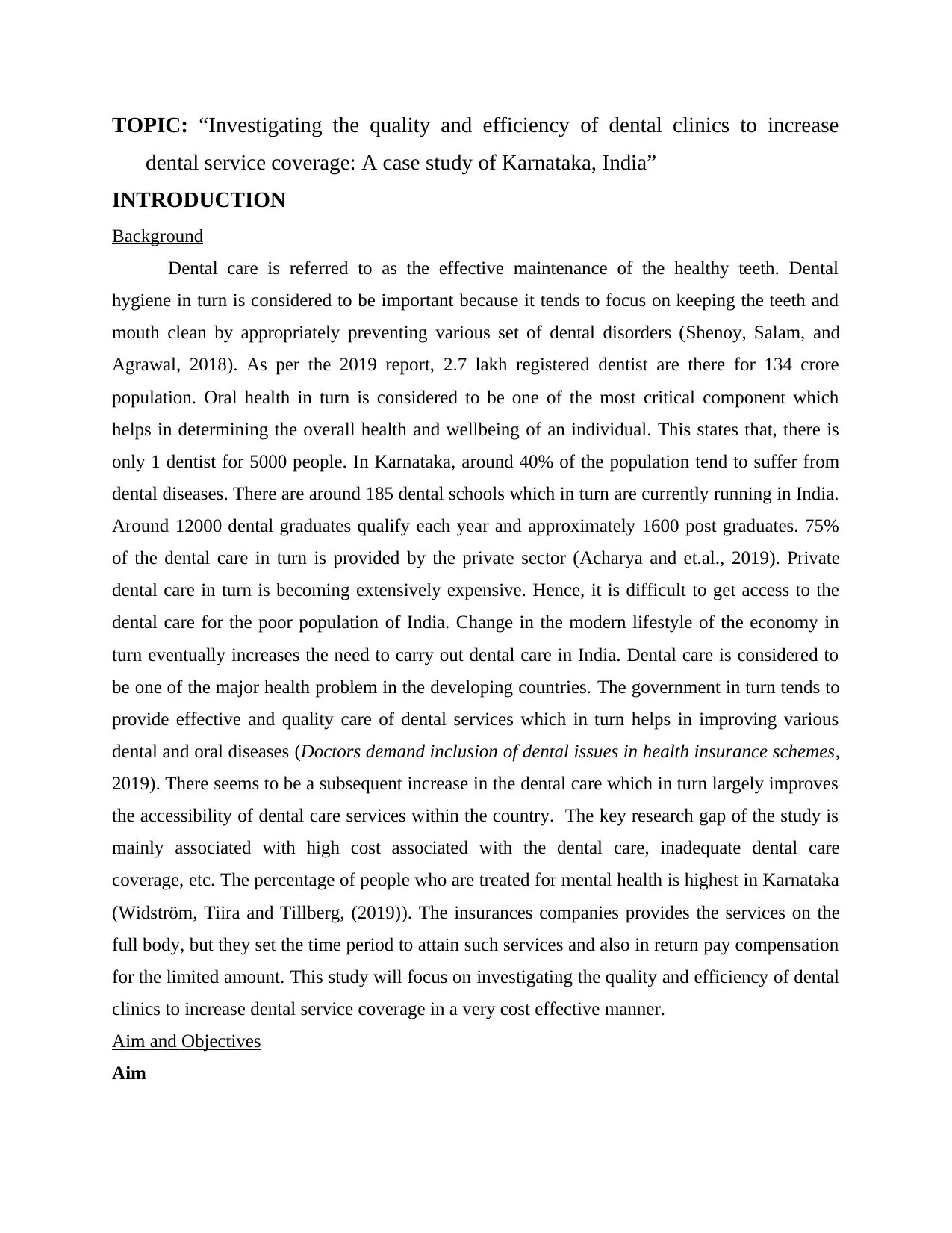
TOPIC: “Investigating the quality and efficiency of dental clinics to increase
dental service coverage: A case study of Karnataka, India”
INTRODUCTION
Background
Dental care is referred to as the effective maintenance of the healthy teeth. Dental
hygiene in turn is considered to be important because it tends to focus on keeping the teeth and
mouth clean by appropriately preventing various set of dental disorders (Shenoy, Salam, and
Agrawal, 2018). As per the 2019 report, 2.7 lakh registered dentist are there for 134 crore
population. Oral health in turn is considered to be one of the most critical component which
helps in determining the overall health and wellbeing of an individual. This states that, there is
only 1 dentist for 5000 people. In Karnataka, around 40% of the population tend to suffer from
dental diseases. There are around 185 dental schools which in turn are currently running in India.
Around 12000 dental graduates qualify each year and approximately 1600 post graduates. 75%
of the dental care in turn is provided by the private sector (Acharya and et.al., 2019). Private
dental care in turn is becoming extensively expensive. Hence, it is difficult to get access to the
dental care for the poor population of India. Change in the modern lifestyle of the economy in
turn eventually increases the need to carry out dental care in India. Dental care is considered to
be one of the major health problem in the developing countries. The government in turn tends to
provide effective and quality care of dental services which in turn helps in improving various
dental and oral diseases (Doctors demand inclusion of dental issues in health insurance schemes,
2019). There seems to be a subsequent increase in the dental care which in turn largely improves
the accessibility of dental care services within the country. The key research gap of the study is
mainly associated with high cost associated with the dental care, inadequate dental care
coverage, etc. The percentage of people who are treated for mental health is highest in Karnataka
(Widström, Tiira and Tillberg, (2019)). The insurances companies provides the services on the
full body, but they set the time period to attain such services and also in return pay compensation
for the limited amount. This study will focus on investigating the quality and efficiency of dental
clinics to increase dental service coverage in a very cost effective manner.
Aim and Objectives
Aim
dental service coverage: A case study of Karnataka, India”
INTRODUCTION
Background
Dental care is referred to as the effective maintenance of the healthy teeth. Dental
hygiene in turn is considered to be important because it tends to focus on keeping the teeth and
mouth clean by appropriately preventing various set of dental disorders (Shenoy, Salam, and
Agrawal, 2018). As per the 2019 report, 2.7 lakh registered dentist are there for 134 crore
population. Oral health in turn is considered to be one of the most critical component which
helps in determining the overall health and wellbeing of an individual. This states that, there is
only 1 dentist for 5000 people. In Karnataka, around 40% of the population tend to suffer from
dental diseases. There are around 185 dental schools which in turn are currently running in India.
Around 12000 dental graduates qualify each year and approximately 1600 post graduates. 75%
of the dental care in turn is provided by the private sector (Acharya and et.al., 2019). Private
dental care in turn is becoming extensively expensive. Hence, it is difficult to get access to the
dental care for the poor population of India. Change in the modern lifestyle of the economy in
turn eventually increases the need to carry out dental care in India. Dental care is considered to
be one of the major health problem in the developing countries. The government in turn tends to
provide effective and quality care of dental services which in turn helps in improving various
dental and oral diseases (Doctors demand inclusion of dental issues in health insurance schemes,
2019). There seems to be a subsequent increase in the dental care which in turn largely improves
the accessibility of dental care services within the country. The key research gap of the study is
mainly associated with high cost associated with the dental care, inadequate dental care
coverage, etc. The percentage of people who are treated for mental health is highest in Karnataka
(Widström, Tiira and Tillberg, (2019)). The insurances companies provides the services on the
full body, but they set the time period to attain such services and also in return pay compensation
for the limited amount. This study will focus on investigating the quality and efficiency of dental
clinics to increase dental service coverage in a very cost effective manner.
Aim and Objectives
Aim
⊘ This is a preview!⊘
Do you want full access?
Subscribe today to unlock all pages.

Trusted by 1+ million students worldwide
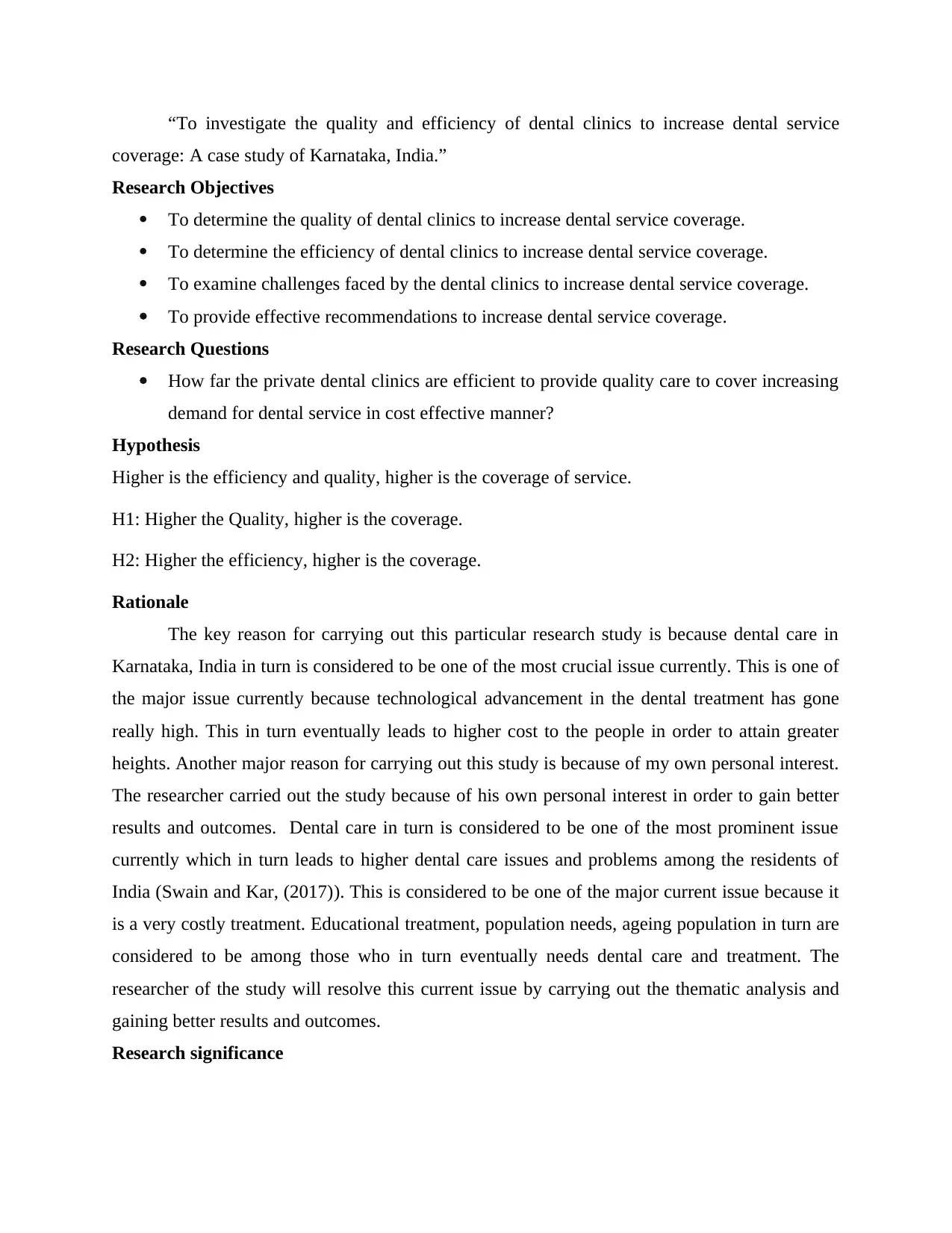
“To investigate the quality and efficiency of dental clinics to increase dental service
coverage: A case study of Karnataka, India.”
Research Objectives
To determine the quality of dental clinics to increase dental service coverage.
To determine the efficiency of dental clinics to increase dental service coverage.
To examine challenges faced by the dental clinics to increase dental service coverage.
To provide effective recommendations to increase dental service coverage.
Research Questions
How far the private dental clinics are efficient to provide quality care to cover increasing
demand for dental service in cost effective manner?
Hypothesis
Higher is the efficiency and quality, higher is the coverage of service.
H1: Higher the Quality, higher is the coverage.
H2: Higher the efficiency, higher is the coverage.
Rationale
The key reason for carrying out this particular research study is because dental care in
Karnataka, India in turn is considered to be one of the most crucial issue currently. This is one of
the major issue currently because technological advancement in the dental treatment has gone
really high. This in turn eventually leads to higher cost to the people in order to attain greater
heights. Another major reason for carrying out this study is because of my own personal interest.
The researcher carried out the study because of his own personal interest in order to gain better
results and outcomes. Dental care in turn is considered to be one of the most prominent issue
currently which in turn leads to higher dental care issues and problems among the residents of
India (Swain and Kar, (2017)). This is considered to be one of the major current issue because it
is a very costly treatment. Educational treatment, population needs, ageing population in turn are
considered to be among those who in turn eventually needs dental care and treatment. The
researcher of the study will resolve this current issue by carrying out the thematic analysis and
gaining better results and outcomes.
Research significance
coverage: A case study of Karnataka, India.”
Research Objectives
To determine the quality of dental clinics to increase dental service coverage.
To determine the efficiency of dental clinics to increase dental service coverage.
To examine challenges faced by the dental clinics to increase dental service coverage.
To provide effective recommendations to increase dental service coverage.
Research Questions
How far the private dental clinics are efficient to provide quality care to cover increasing
demand for dental service in cost effective manner?
Hypothesis
Higher is the efficiency and quality, higher is the coverage of service.
H1: Higher the Quality, higher is the coverage.
H2: Higher the efficiency, higher is the coverage.
Rationale
The key reason for carrying out this particular research study is because dental care in
Karnataka, India in turn is considered to be one of the most crucial issue currently. This is one of
the major issue currently because technological advancement in the dental treatment has gone
really high. This in turn eventually leads to higher cost to the people in order to attain greater
heights. Another major reason for carrying out this study is because of my own personal interest.
The researcher carried out the study because of his own personal interest in order to gain better
results and outcomes. Dental care in turn is considered to be one of the most prominent issue
currently which in turn leads to higher dental care issues and problems among the residents of
India (Swain and Kar, (2017)). This is considered to be one of the major current issue because it
is a very costly treatment. Educational treatment, population needs, ageing population in turn are
considered to be among those who in turn eventually needs dental care and treatment. The
researcher of the study will resolve this current issue by carrying out the thematic analysis and
gaining better results and outcomes.
Research significance
Paraphrase This Document
Need a fresh take? Get an instant paraphrase of this document with our AI Paraphraser

The key benefit of carrying out this research is that it helps in gaining knowledge on the
quality and efficiency of dental clinics to increase dental service coverage. The researcher of the
study also demonstrates that, this study is very beneficial for the government of India in order to
determine the dental care which in turn has been required to effectively examine the number of
dentist required to resolve various health problems (Kundabala, Shenoy and Shetty, 2018). This
research is going to be very beneficial for the private and public dental institutions in order to
examine the need of dental care in the modern age. The researcher of the study will also be
benefited from carrying out the specific research study is that, it will help in bridging the gaps on
the particular subject matter. The researcher of the study will focus on critically evaluating how
far the private dental clinics are efficient to provide quality care to cover increasing demand for
dental service in cost effective manner. This helps in improving the outcomes and gain better
results and outcomes in accordance with the specific subject matter. This study will be beneficial
for the health and social care industry who will grasp relevant knowledge associated with the
quality and efficiency of dental clinics to increase dental service coverage. This study will be
beneficial for the future researcher in order to examine the odds, problems, trends and patterns
associated with the research gap. This research study is also very beneficial for various dental
schools and institutes in India in order to gain better and relevant outcomes on the aims and
objective of the research.
Chapter structure
Introduction:This is considered to be the first and foremost chapter of the dissertation
which in turn focuses on effectively outlining the aims and objectives of the research. This
chapter helps in briefing out the proper explanation associated with the research background,
rationale and significance of the research study.
Literature Review:This chapter mainly comprise of the various frameworks, approach
and models which in turn has been previously introduced to the specific research area. This study
is useful in grasping to the viewpoints of various authors in relation with the specific research
area in general. This helps in bridging the gaps to the various research problem in a logical and
systematic manner.
Research methodology: This chapter in turn effectively addresses the various issues
related to the specific research study. This study helps in determining whether qualitative or
quantitative research approach will be selected in order to gain better results and outcomes. This
quality and efficiency of dental clinics to increase dental service coverage. The researcher of the
study also demonstrates that, this study is very beneficial for the government of India in order to
determine the dental care which in turn has been required to effectively examine the number of
dentist required to resolve various health problems (Kundabala, Shenoy and Shetty, 2018). This
research is going to be very beneficial for the private and public dental institutions in order to
examine the need of dental care in the modern age. The researcher of the study will also be
benefited from carrying out the specific research study is that, it will help in bridging the gaps on
the particular subject matter. The researcher of the study will focus on critically evaluating how
far the private dental clinics are efficient to provide quality care to cover increasing demand for
dental service in cost effective manner. This helps in improving the outcomes and gain better
results and outcomes in accordance with the specific subject matter. This study will be beneficial
for the health and social care industry who will grasp relevant knowledge associated with the
quality and efficiency of dental clinics to increase dental service coverage. This study will be
beneficial for the future researcher in order to examine the odds, problems, trends and patterns
associated with the research gap. This research study is also very beneficial for various dental
schools and institutes in India in order to gain better and relevant outcomes on the aims and
objective of the research.
Chapter structure
Introduction:This is considered to be the first and foremost chapter of the dissertation
which in turn focuses on effectively outlining the aims and objectives of the research. This
chapter helps in briefing out the proper explanation associated with the research background,
rationale and significance of the research study.
Literature Review:This chapter mainly comprise of the various frameworks, approach
and models which in turn has been previously introduced to the specific research area. This study
is useful in grasping to the viewpoints of various authors in relation with the specific research
area in general. This helps in bridging the gaps to the various research problem in a logical and
systematic manner.
Research methodology: This chapter in turn effectively addresses the various issues
related to the specific research study. This study helps in determining whether qualitative or
quantitative research approach will be selected in order to gain better results and outcomes. This

methodology in turn is considered to be very useful because it helps in effectively addressing
issues associated with the research philosophy.
Data analysis and findings: This chapter mainly comprise of discussion and analysis of
the data collected. This chapter tends to play a very critical role in order to achieve the aims and
objectives of the research study. This chapter tends to carry out in- depth discussion of the data
gathered from proper and relevant sources in order to attain set results.
Conclusion and recommendation: This chapter in turn focuses on summarizing the data
by effectively determining the key and relevant points of the research which helps in attaining
aims and objective. This chapter also focuses on giving proper recommendation associated with
the specific subject matter. This helps in improving the outcomes of the study in order to gain
higher degree of knowledge in the mere future.
LITERATURE REVIEW
Literature review tends to comprise of the frameworks, approach and models which has
been previously introduced on the specific research area. Literature review helps in grasping to
the viewpoints of various authors in order to reduce the research gap and effectively solve
research problems in a logical and systematic manner (Byrne and Tickle, (2019)). It us referred
to as a survey who in turn tends to focus on evaluating the various scholarly papers such as
thesis, books and journal articles associated with the specific research topic. This helps in
situating the work associated with the existing knowledge of the particular research study.
Part 1: Problem statement
To determine the gaps associated with how far the private dental clinics are efficient to
provide quality care to cover increasing demand for dental service in cost effective manner.
Part 2
To investigate the quality and efficiency of dental clinics to increase dental service coverage: A
case study of Karnataka, India.
Shenoy, Salam and Agrawal, (2018) sought to determine the fact that, quality and
efficiency in dental clinics must be effectively maintained in order to effectively ensure that they
tend to increase dental service coverage. Dental hygiene is considered to be the most prominent
because it helps in keeping the teeth and mouth clean by appropriately preventing various set of
dental disorders. Change in modern lifestyle in turn has eventually led to increase in the level of
dental care needs across India. Consequently, Kundabala, Shenoy and Shetty, (2018)
issues associated with the research philosophy.
Data analysis and findings: This chapter mainly comprise of discussion and analysis of
the data collected. This chapter tends to play a very critical role in order to achieve the aims and
objectives of the research study. This chapter tends to carry out in- depth discussion of the data
gathered from proper and relevant sources in order to attain set results.
Conclusion and recommendation: This chapter in turn focuses on summarizing the data
by effectively determining the key and relevant points of the research which helps in attaining
aims and objective. This chapter also focuses on giving proper recommendation associated with
the specific subject matter. This helps in improving the outcomes of the study in order to gain
higher degree of knowledge in the mere future.
LITERATURE REVIEW
Literature review tends to comprise of the frameworks, approach and models which has
been previously introduced on the specific research area. Literature review helps in grasping to
the viewpoints of various authors in order to reduce the research gap and effectively solve
research problems in a logical and systematic manner (Byrne and Tickle, (2019)). It us referred
to as a survey who in turn tends to focus on evaluating the various scholarly papers such as
thesis, books and journal articles associated with the specific research topic. This helps in
situating the work associated with the existing knowledge of the particular research study.
Part 1: Problem statement
To determine the gaps associated with how far the private dental clinics are efficient to
provide quality care to cover increasing demand for dental service in cost effective manner.
Part 2
To investigate the quality and efficiency of dental clinics to increase dental service coverage: A
case study of Karnataka, India.
Shenoy, Salam and Agrawal, (2018) sought to determine the fact that, quality and
efficiency in dental clinics must be effectively maintained in order to effectively ensure that they
tend to increase dental service coverage. Dental hygiene is considered to be the most prominent
because it helps in keeping the teeth and mouth clean by appropriately preventing various set of
dental disorders. Change in modern lifestyle in turn has eventually led to increase in the level of
dental care needs across India. Consequently, Kundabala, Shenoy and Shetty, (2018)
⊘ This is a preview!⊘
Do you want full access?
Subscribe today to unlock all pages.

Trusted by 1+ million students worldwide
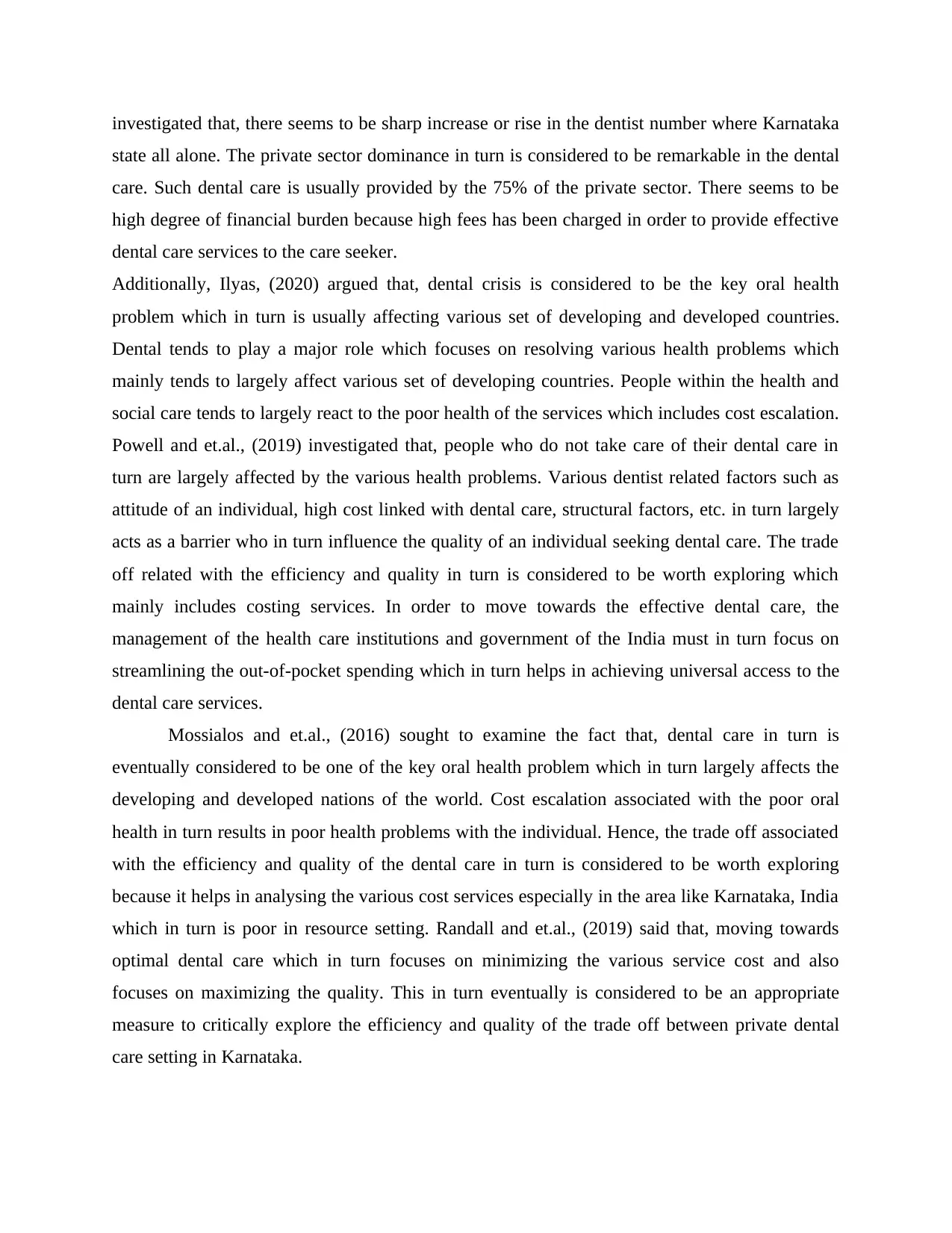
investigated that, there seems to be sharp increase or rise in the dentist number where Karnataka
state all alone. The private sector dominance in turn is considered to be remarkable in the dental
care. Such dental care is usually provided by the 75% of the private sector. There seems to be
high degree of financial burden because high fees has been charged in order to provide effective
dental care services to the care seeker.
Additionally, Ilyas, (2020) argued that, dental crisis is considered to be the key oral health
problem which in turn is usually affecting various set of developing and developed countries.
Dental tends to play a major role which focuses on resolving various health problems which
mainly tends to largely affect various set of developing countries. People within the health and
social care tends to largely react to the poor health of the services which includes cost escalation.
Powell and et.al., (2019) investigated that, people who do not take care of their dental care in
turn are largely affected by the various health problems. Various dentist related factors such as
attitude of an individual, high cost linked with dental care, structural factors, etc. in turn largely
acts as a barrier who in turn influence the quality of an individual seeking dental care. The trade
off related with the efficiency and quality in turn is considered to be worth exploring which
mainly includes costing services. In order to move towards the effective dental care, the
management of the health care institutions and government of the India must in turn focus on
streamlining the out-of-pocket spending which in turn helps in achieving universal access to the
dental care services.
Mossialos and et.al., (2016) sought to examine the fact that, dental care in turn is
eventually considered to be one of the key oral health problem which in turn largely affects the
developing and developed nations of the world. Cost escalation associated with the poor oral
health in turn results in poor health problems with the individual. Hence, the trade off associated
with the efficiency and quality of the dental care in turn is considered to be worth exploring
because it helps in analysing the various cost services especially in the area like Karnataka, India
which in turn is poor in resource setting. Randall and et.al., (2019) said that, moving towards
optimal dental care which in turn focuses on minimizing the various service cost and also
focuses on maximizing the quality. This in turn eventually is considered to be an appropriate
measure to critically explore the efficiency and quality of the trade off between private dental
care setting in Karnataka.
state all alone. The private sector dominance in turn is considered to be remarkable in the dental
care. Such dental care is usually provided by the 75% of the private sector. There seems to be
high degree of financial burden because high fees has been charged in order to provide effective
dental care services to the care seeker.
Additionally, Ilyas, (2020) argued that, dental crisis is considered to be the key oral health
problem which in turn is usually affecting various set of developing and developed countries.
Dental tends to play a major role which focuses on resolving various health problems which
mainly tends to largely affect various set of developing countries. People within the health and
social care tends to largely react to the poor health of the services which includes cost escalation.
Powell and et.al., (2019) investigated that, people who do not take care of their dental care in
turn are largely affected by the various health problems. Various dentist related factors such as
attitude of an individual, high cost linked with dental care, structural factors, etc. in turn largely
acts as a barrier who in turn influence the quality of an individual seeking dental care. The trade
off related with the efficiency and quality in turn is considered to be worth exploring which
mainly includes costing services. In order to move towards the effective dental care, the
management of the health care institutions and government of the India must in turn focus on
streamlining the out-of-pocket spending which in turn helps in achieving universal access to the
dental care services.
Mossialos and et.al., (2016) sought to examine the fact that, dental care in turn is
eventually considered to be one of the key oral health problem which in turn largely affects the
developing and developed nations of the world. Cost escalation associated with the poor oral
health in turn results in poor health problems with the individual. Hence, the trade off associated
with the efficiency and quality of the dental care in turn is considered to be worth exploring
because it helps in analysing the various cost services especially in the area like Karnataka, India
which in turn is poor in resource setting. Randall and et.al., (2019) said that, moving towards
optimal dental care which in turn focuses on minimizing the various service cost and also
focuses on maximizing the quality. This in turn eventually is considered to be an appropriate
measure to critically explore the efficiency and quality of the trade off between private dental
care setting in Karnataka.
Paraphrase This Document
Need a fresh take? Get an instant paraphrase of this document with our AI Paraphraser
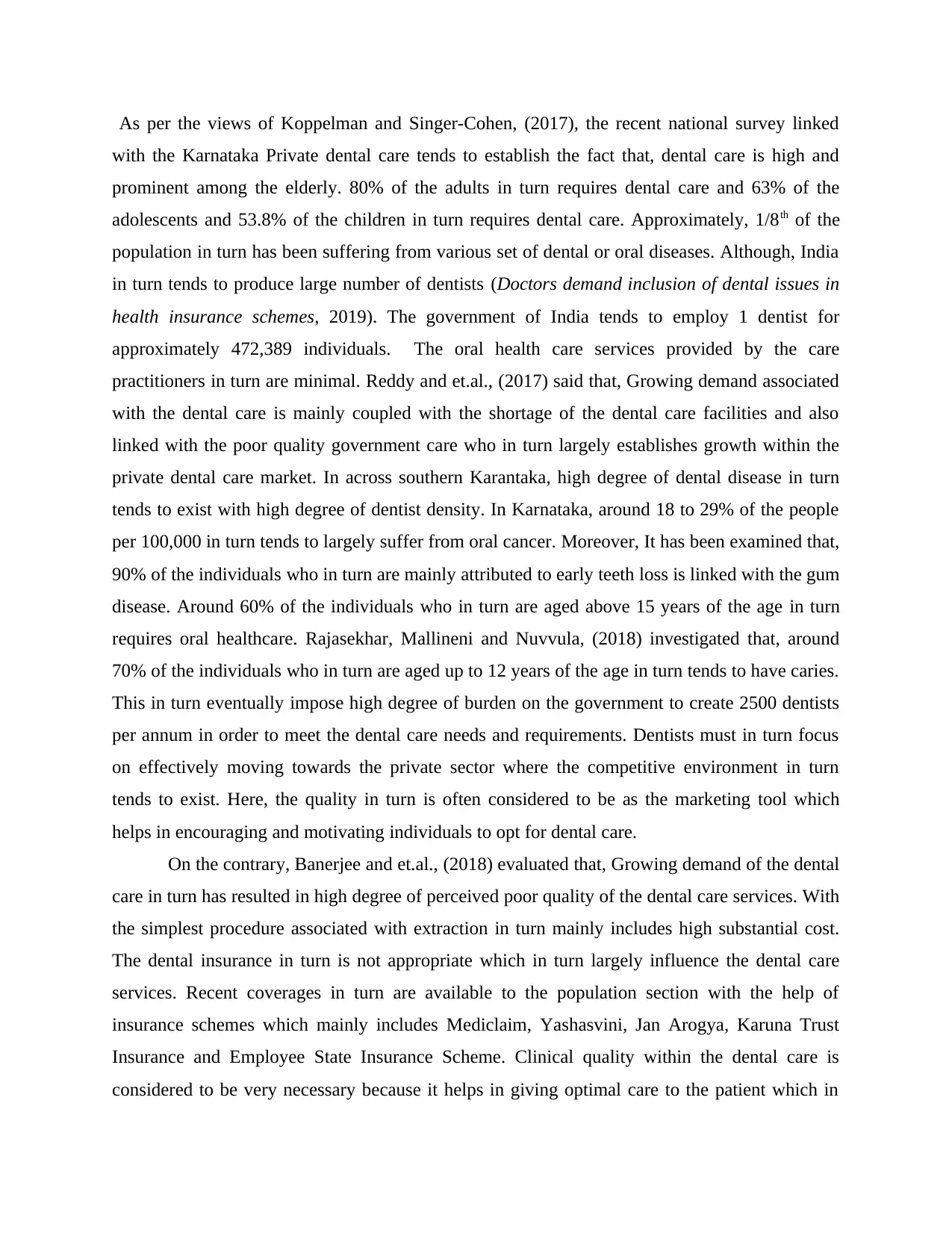
As per the views of Koppelman and Singer-Cohen, (2017), the recent national survey linked
with the Karnataka Private dental care tends to establish the fact that, dental care is high and
prominent among the elderly. 80% of the adults in turn requires dental care and 63% of the
adolescents and 53.8% of the children in turn requires dental care. Approximately, 1/8th of the
population in turn has been suffering from various set of dental or oral diseases. Although, India
in turn tends to produce large number of dentists (Doctors demand inclusion of dental issues in
health insurance schemes, 2019). The government of India tends to employ 1 dentist for
approximately 472,389 individuals. The oral health care services provided by the care
practitioners in turn are minimal. Reddy and et.al., (2017) said that, Growing demand associated
with the dental care is mainly coupled with the shortage of the dental care facilities and also
linked with the poor quality government care who in turn largely establishes growth within the
private dental care market. In across southern Karantaka, high degree of dental disease in turn
tends to exist with high degree of dentist density. In Karnataka, around 18 to 29% of the people
per 100,000 in turn tends to largely suffer from oral cancer. Moreover, It has been examined that,
90% of the individuals who in turn are mainly attributed to early teeth loss is linked with the gum
disease. Around 60% of the individuals who in turn are aged above 15 years of the age in turn
requires oral healthcare. Rajasekhar, Mallineni and Nuvvula, (2018) investigated that, around
70% of the individuals who in turn are aged up to 12 years of the age in turn tends to have caries.
This in turn eventually impose high degree of burden on the government to create 2500 dentists
per annum in order to meet the dental care needs and requirements. Dentists must in turn focus
on effectively moving towards the private sector where the competitive environment in turn
tends to exist. Here, the quality in turn is often considered to be as the marketing tool which
helps in encouraging and motivating individuals to opt for dental care.
On the contrary, Banerjee and et.al., (2018) evaluated that, Growing demand of the dental
care in turn has resulted in high degree of perceived poor quality of the dental care services. With
the simplest procedure associated with extraction in turn mainly includes high substantial cost.
The dental insurance in turn is not appropriate which in turn largely influence the dental care
services. Recent coverages in turn are available to the population section with the help of
insurance schemes which mainly includes Mediclaim, Yashasvini, Jan Arogya, Karuna Trust
Insurance and Employee State Insurance Scheme. Clinical quality within the dental care is
considered to be very necessary because it helps in giving optimal care to the patient which in
with the Karnataka Private dental care tends to establish the fact that, dental care is high and
prominent among the elderly. 80% of the adults in turn requires dental care and 63% of the
adolescents and 53.8% of the children in turn requires dental care. Approximately, 1/8th of the
population in turn has been suffering from various set of dental or oral diseases. Although, India
in turn tends to produce large number of dentists (Doctors demand inclusion of dental issues in
health insurance schemes, 2019). The government of India tends to employ 1 dentist for
approximately 472,389 individuals. The oral health care services provided by the care
practitioners in turn are minimal. Reddy and et.al., (2017) said that, Growing demand associated
with the dental care is mainly coupled with the shortage of the dental care facilities and also
linked with the poor quality government care who in turn largely establishes growth within the
private dental care market. In across southern Karantaka, high degree of dental disease in turn
tends to exist with high degree of dentist density. In Karnataka, around 18 to 29% of the people
per 100,000 in turn tends to largely suffer from oral cancer. Moreover, It has been examined that,
90% of the individuals who in turn are mainly attributed to early teeth loss is linked with the gum
disease. Around 60% of the individuals who in turn are aged above 15 years of the age in turn
requires oral healthcare. Rajasekhar, Mallineni and Nuvvula, (2018) investigated that, around
70% of the individuals who in turn are aged up to 12 years of the age in turn tends to have caries.
This in turn eventually impose high degree of burden on the government to create 2500 dentists
per annum in order to meet the dental care needs and requirements. Dentists must in turn focus
on effectively moving towards the private sector where the competitive environment in turn
tends to exist. Here, the quality in turn is often considered to be as the marketing tool which
helps in encouraging and motivating individuals to opt for dental care.
On the contrary, Banerjee and et.al., (2018) evaluated that, Growing demand of the dental
care in turn has resulted in high degree of perceived poor quality of the dental care services. With
the simplest procedure associated with extraction in turn mainly includes high substantial cost.
The dental insurance in turn is not appropriate which in turn largely influence the dental care
services. Recent coverages in turn are available to the population section with the help of
insurance schemes which mainly includes Mediclaim, Yashasvini, Jan Arogya, Karuna Trust
Insurance and Employee State Insurance Scheme. Clinical quality within the dental care is
considered to be very necessary because it helps in giving optimal care to the patient which in
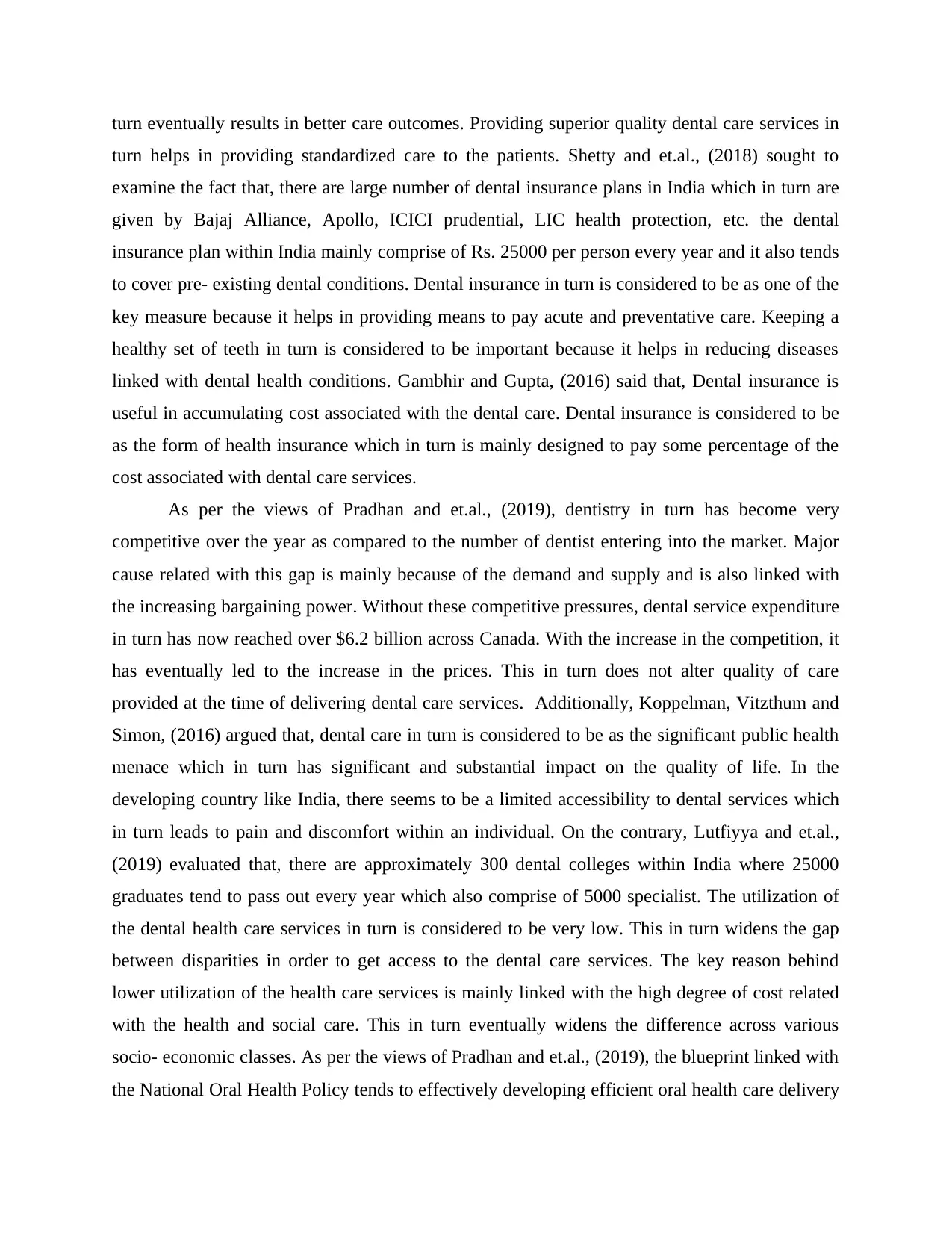
turn eventually results in better care outcomes. Providing superior quality dental care services in
turn helps in providing standardized care to the patients. Shetty and et.al., (2018) sought to
examine the fact that, there are large number of dental insurance plans in India which in turn are
given by Bajaj Alliance, Apollo, ICICI prudential, LIC health protection, etc. the dental
insurance plan within India mainly comprise of Rs. 25000 per person every year and it also tends
to cover pre- existing dental conditions. Dental insurance in turn is considered to be as one of the
key measure because it helps in providing means to pay acute and preventative care. Keeping a
healthy set of teeth in turn is considered to be important because it helps in reducing diseases
linked with dental health conditions. Gambhir and Gupta, (2016) said that, Dental insurance is
useful in accumulating cost associated with the dental care. Dental insurance is considered to be
as the form of health insurance which in turn is mainly designed to pay some percentage of the
cost associated with dental care services.
As per the views of Pradhan and et.al., (2019), dentistry in turn has become very
competitive over the year as compared to the number of dentist entering into the market. Major
cause related with this gap is mainly because of the demand and supply and is also linked with
the increasing bargaining power. Without these competitive pressures, dental service expenditure
in turn has now reached over $6.2 billion across Canada. With the increase in the competition, it
has eventually led to the increase in the prices. This in turn does not alter quality of care
provided at the time of delivering dental care services. Additionally, Koppelman, Vitzthum and
Simon, (2016) argued that, dental care in turn is considered to be as the significant public health
menace which in turn has significant and substantial impact on the quality of life. In the
developing country like India, there seems to be a limited accessibility to dental services which
in turn leads to pain and discomfort within an individual. On the contrary, Lutfiyya and et.al.,
(2019) evaluated that, there are approximately 300 dental colleges within India where 25000
graduates tend to pass out every year which also comprise of 5000 specialist. The utilization of
the dental health care services in turn is considered to be very low. This in turn widens the gap
between disparities in order to get access to the dental care services. The key reason behind
lower utilization of the health care services is mainly linked with the high degree of cost related
with the health and social care. This in turn eventually widens the difference across various
socio- economic classes. As per the views of Pradhan and et.al., (2019), the blueprint linked with
the National Oral Health Policy tends to effectively developing efficient oral health care delivery
turn helps in providing standardized care to the patients. Shetty and et.al., (2018) sought to
examine the fact that, there are large number of dental insurance plans in India which in turn are
given by Bajaj Alliance, Apollo, ICICI prudential, LIC health protection, etc. the dental
insurance plan within India mainly comprise of Rs. 25000 per person every year and it also tends
to cover pre- existing dental conditions. Dental insurance in turn is considered to be as one of the
key measure because it helps in providing means to pay acute and preventative care. Keeping a
healthy set of teeth in turn is considered to be important because it helps in reducing diseases
linked with dental health conditions. Gambhir and Gupta, (2016) said that, Dental insurance is
useful in accumulating cost associated with the dental care. Dental insurance is considered to be
as the form of health insurance which in turn is mainly designed to pay some percentage of the
cost associated with dental care services.
As per the views of Pradhan and et.al., (2019), dentistry in turn has become very
competitive over the year as compared to the number of dentist entering into the market. Major
cause related with this gap is mainly because of the demand and supply and is also linked with
the increasing bargaining power. Without these competitive pressures, dental service expenditure
in turn has now reached over $6.2 billion across Canada. With the increase in the competition, it
has eventually led to the increase in the prices. This in turn does not alter quality of care
provided at the time of delivering dental care services. Additionally, Koppelman, Vitzthum and
Simon, (2016) argued that, dental care in turn is considered to be as the significant public health
menace which in turn has significant and substantial impact on the quality of life. In the
developing country like India, there seems to be a limited accessibility to dental services which
in turn leads to pain and discomfort within an individual. On the contrary, Lutfiyya and et.al.,
(2019) evaluated that, there are approximately 300 dental colleges within India where 25000
graduates tend to pass out every year which also comprise of 5000 specialist. The utilization of
the dental health care services in turn is considered to be very low. This in turn widens the gap
between disparities in order to get access to the dental care services. The key reason behind
lower utilization of the health care services is mainly linked with the high degree of cost related
with the health and social care. This in turn eventually widens the difference across various
socio- economic classes. As per the views of Pradhan and et.al., (2019), the blueprint linked with
the National Oral Health Policy tends to effectively developing efficient oral health care delivery
⊘ This is a preview!⊘
Do you want full access?
Subscribe today to unlock all pages.

Trusted by 1+ million students worldwide
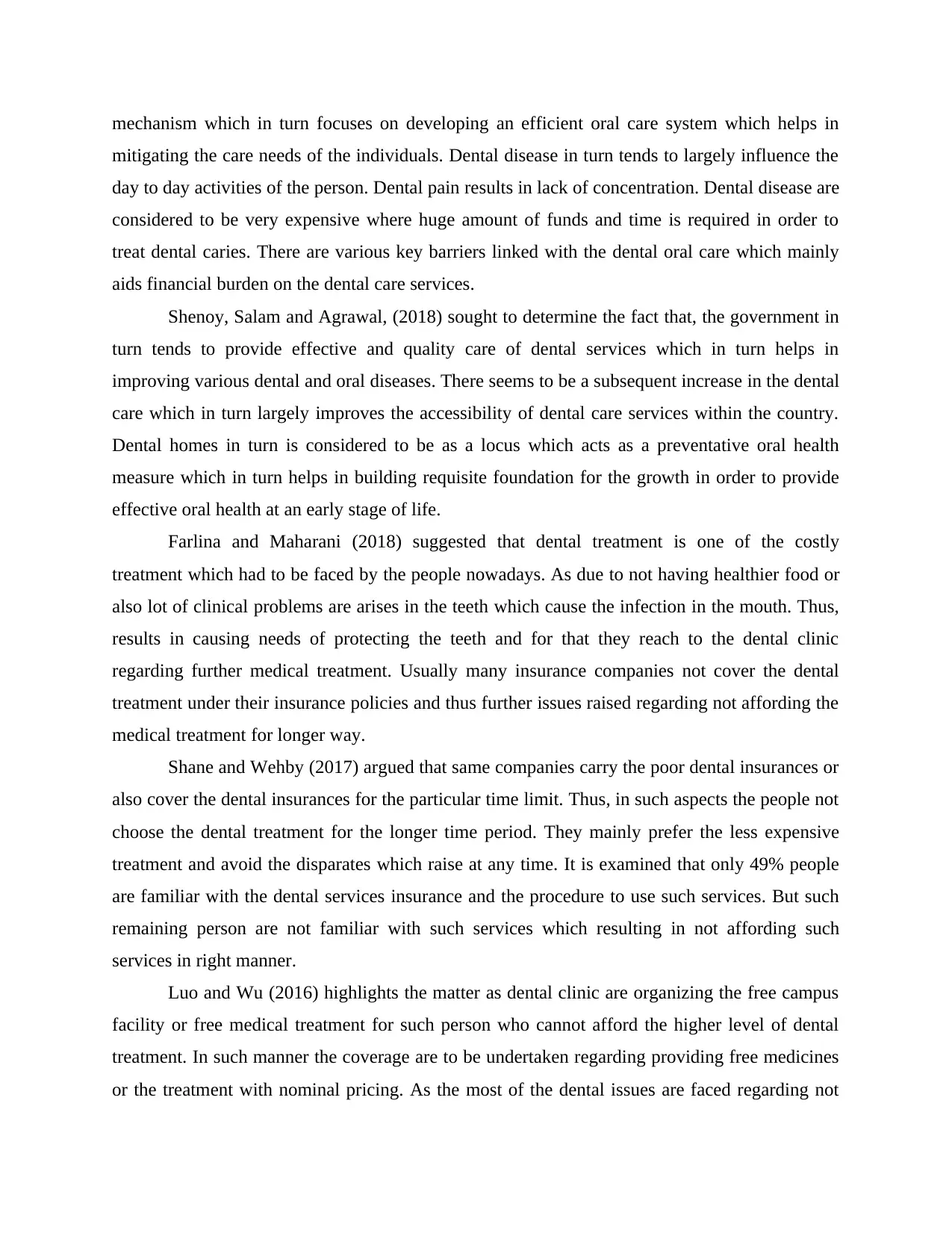
mechanism which in turn focuses on developing an efficient oral care system which helps in
mitigating the care needs of the individuals. Dental disease in turn tends to largely influence the
day to day activities of the person. Dental pain results in lack of concentration. Dental disease are
considered to be very expensive where huge amount of funds and time is required in order to
treat dental caries. There are various key barriers linked with the dental oral care which mainly
aids financial burden on the dental care services.
Shenoy, Salam and Agrawal, (2018) sought to determine the fact that, the government in
turn tends to provide effective and quality care of dental services which in turn helps in
improving various dental and oral diseases. There seems to be a subsequent increase in the dental
care which in turn largely improves the accessibility of dental care services within the country.
Dental homes in turn is considered to be as a locus which acts as a preventative oral health
measure which in turn helps in building requisite foundation for the growth in order to provide
effective oral health at an early stage of life.
Farlina and Maharani (2018) suggested that dental treatment is one of the costly
treatment which had to be faced by the people nowadays. As due to not having healthier food or
also lot of clinical problems are arises in the teeth which cause the infection in the mouth. Thus,
results in causing needs of protecting the teeth and for that they reach to the dental clinic
regarding further medical treatment. Usually many insurance companies not cover the dental
treatment under their insurance policies and thus further issues raised regarding not affording the
medical treatment for longer way.
Shane and Wehby (2017) argued that same companies carry the poor dental insurances or
also cover the dental insurances for the particular time limit. Thus, in such aspects the people not
choose the dental treatment for the longer time period. They mainly prefer the less expensive
treatment and avoid the disparates which raise at any time. It is examined that only 49% people
are familiar with the dental services insurance and the procedure to use such services. But such
remaining person are not familiar with such services which resulting in not affording such
services in right manner.
Luo and Wu (2016) highlights the matter as dental clinic are organizing the free campus
facility or free medical treatment for such person who cannot afford the higher level of dental
treatment. In such manner the coverage are to be undertaken regarding providing free medicines
or the treatment with nominal pricing. As the most of the dental issues are faced regarding not
mitigating the care needs of the individuals. Dental disease in turn tends to largely influence the
day to day activities of the person. Dental pain results in lack of concentration. Dental disease are
considered to be very expensive where huge amount of funds and time is required in order to
treat dental caries. There are various key barriers linked with the dental oral care which mainly
aids financial burden on the dental care services.
Shenoy, Salam and Agrawal, (2018) sought to determine the fact that, the government in
turn tends to provide effective and quality care of dental services which in turn helps in
improving various dental and oral diseases. There seems to be a subsequent increase in the dental
care which in turn largely improves the accessibility of dental care services within the country.
Dental homes in turn is considered to be as a locus which acts as a preventative oral health
measure which in turn helps in building requisite foundation for the growth in order to provide
effective oral health at an early stage of life.
Farlina and Maharani (2018) suggested that dental treatment is one of the costly
treatment which had to be faced by the people nowadays. As due to not having healthier food or
also lot of clinical problems are arises in the teeth which cause the infection in the mouth. Thus,
results in causing needs of protecting the teeth and for that they reach to the dental clinic
regarding further medical treatment. Usually many insurance companies not cover the dental
treatment under their insurance policies and thus further issues raised regarding not affording the
medical treatment for longer way.
Shane and Wehby (2017) argued that same companies carry the poor dental insurances or
also cover the dental insurances for the particular time limit. Thus, in such aspects the people not
choose the dental treatment for the longer time period. They mainly prefer the less expensive
treatment and avoid the disparates which raise at any time. It is examined that only 49% people
are familiar with the dental services insurance and the procedure to use such services. But such
remaining person are not familiar with such services which resulting in not affording such
services in right manner.
Luo and Wu (2016) highlights the matter as dental clinic are organizing the free campus
facility or free medical treatment for such person who cannot afford the higher level of dental
treatment. In such manner the coverage are to be undertaken regarding providing free medicines
or the treatment with nominal pricing. As the most of the dental issues are faced regarding not
Paraphrase This Document
Need a fresh take? Get an instant paraphrase of this document with our AI Paraphraser
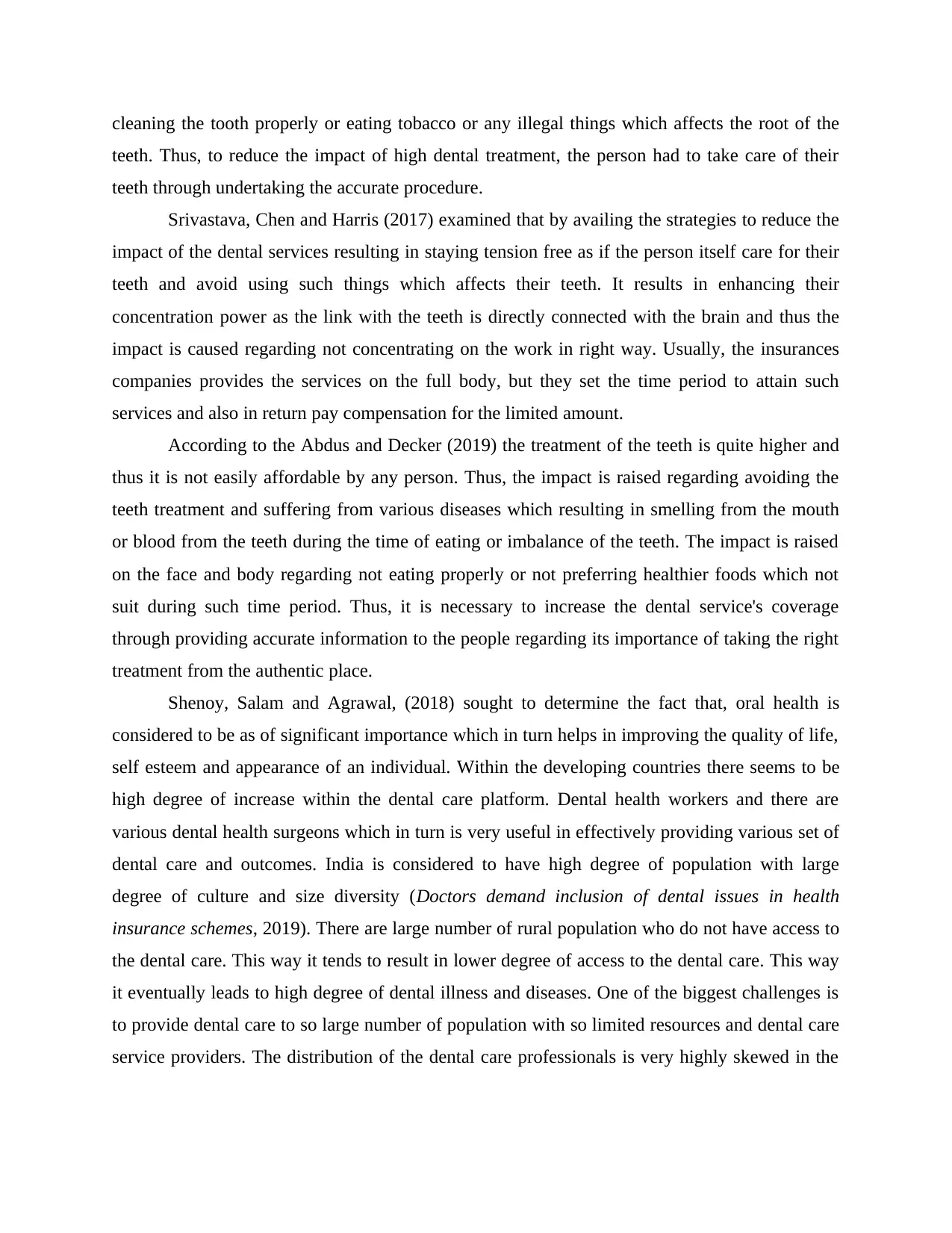
cleaning the tooth properly or eating tobacco or any illegal things which affects the root of the
teeth. Thus, to reduce the impact of high dental treatment, the person had to take care of their
teeth through undertaking the accurate procedure.
Srivastava, Chen and Harris (2017) examined that by availing the strategies to reduce the
impact of the dental services resulting in staying tension free as if the person itself care for their
teeth and avoid using such things which affects their teeth. It results in enhancing their
concentration power as the link with the teeth is directly connected with the brain and thus the
impact is caused regarding not concentrating on the work in right way. Usually, the insurances
companies provides the services on the full body, but they set the time period to attain such
services and also in return pay compensation for the limited amount.
According to the Abdus and Decker (2019) the treatment of the teeth is quite higher and
thus it is not easily affordable by any person. Thus, the impact is raised regarding avoiding the
teeth treatment and suffering from various diseases which resulting in smelling from the mouth
or blood from the teeth during the time of eating or imbalance of the teeth. The impact is raised
on the face and body regarding not eating properly or not preferring healthier foods which not
suit during such time period. Thus, it is necessary to increase the dental service's coverage
through providing accurate information to the people regarding its importance of taking the right
treatment from the authentic place.
Shenoy, Salam and Agrawal, (2018) sought to determine the fact that, oral health is
considered to be as of significant importance which in turn helps in improving the quality of life,
self esteem and appearance of an individual. Within the developing countries there seems to be
high degree of increase within the dental care platform. Dental health workers and there are
various dental health surgeons which in turn is very useful in effectively providing various set of
dental care and outcomes. India is considered to have high degree of population with large
degree of culture and size diversity (Doctors demand inclusion of dental issues in health
insurance schemes, 2019). There are large number of rural population who do not have access to
the dental care. This way it tends to result in lower degree of access to the dental care. This way
it eventually leads to high degree of dental illness and diseases. One of the biggest challenges is
to provide dental care to so large number of population with so limited resources and dental care
service providers. The distribution of the dental care professionals is very highly skewed in the
teeth. Thus, to reduce the impact of high dental treatment, the person had to take care of their
teeth through undertaking the accurate procedure.
Srivastava, Chen and Harris (2017) examined that by availing the strategies to reduce the
impact of the dental services resulting in staying tension free as if the person itself care for their
teeth and avoid using such things which affects their teeth. It results in enhancing their
concentration power as the link with the teeth is directly connected with the brain and thus the
impact is caused regarding not concentrating on the work in right way. Usually, the insurances
companies provides the services on the full body, but they set the time period to attain such
services and also in return pay compensation for the limited amount.
According to the Abdus and Decker (2019) the treatment of the teeth is quite higher and
thus it is not easily affordable by any person. Thus, the impact is raised regarding avoiding the
teeth treatment and suffering from various diseases which resulting in smelling from the mouth
or blood from the teeth during the time of eating or imbalance of the teeth. The impact is raised
on the face and body regarding not eating properly or not preferring healthier foods which not
suit during such time period. Thus, it is necessary to increase the dental service's coverage
through providing accurate information to the people regarding its importance of taking the right
treatment from the authentic place.
Shenoy, Salam and Agrawal, (2018) sought to determine the fact that, oral health is
considered to be as of significant importance which in turn helps in improving the quality of life,
self esteem and appearance of an individual. Within the developing countries there seems to be
high degree of increase within the dental care platform. Dental health workers and there are
various dental health surgeons which in turn is very useful in effectively providing various set of
dental care and outcomes. India is considered to have high degree of population with large
degree of culture and size diversity (Doctors demand inclusion of dental issues in health
insurance schemes, 2019). There are large number of rural population who do not have access to
the dental care. This way it tends to result in lower degree of access to the dental care. This way
it eventually leads to high degree of dental illness and diseases. One of the biggest challenges is
to provide dental care to so large number of population with so limited resources and dental care
service providers. The distribution of the dental care professionals is very highly skewed in the
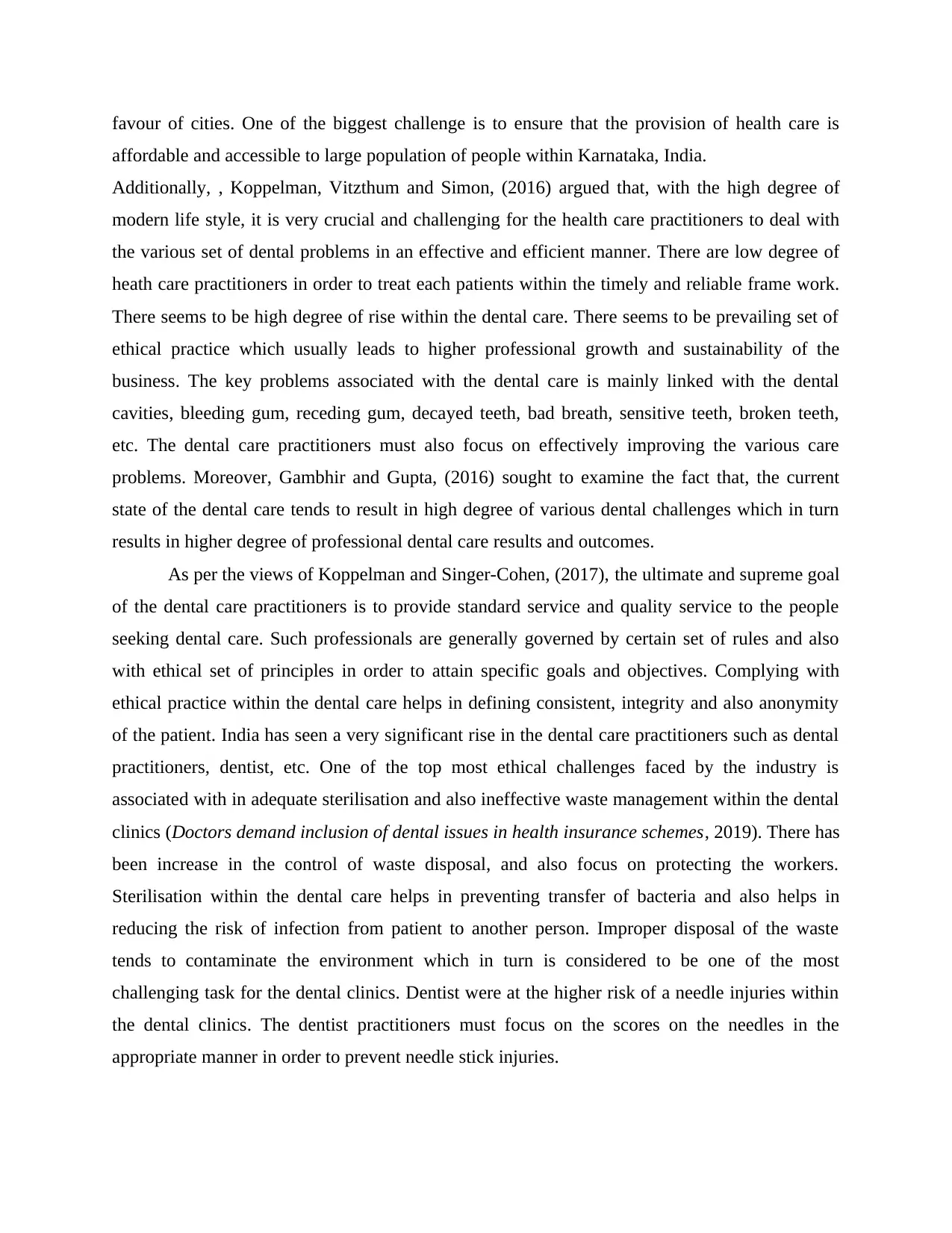
favour of cities. One of the biggest challenge is to ensure that the provision of health care is
affordable and accessible to large population of people within Karnataka, India.
Additionally, , Koppelman, Vitzthum and Simon, (2016) argued that, with the high degree of
modern life style, it is very crucial and challenging for the health care practitioners to deal with
the various set of dental problems in an effective and efficient manner. There are low degree of
heath care practitioners in order to treat each patients within the timely and reliable frame work.
There seems to be high degree of rise within the dental care. There seems to be prevailing set of
ethical practice which usually leads to higher professional growth and sustainability of the
business. The key problems associated with the dental care is mainly linked with the dental
cavities, bleeding gum, receding gum, decayed teeth, bad breath, sensitive teeth, broken teeth,
etc. The dental care practitioners must also focus on effectively improving the various care
problems. Moreover, Gambhir and Gupta, (2016) sought to examine the fact that, the current
state of the dental care tends to result in high degree of various dental challenges which in turn
results in higher degree of professional dental care results and outcomes.
As per the views of Koppelman and Singer-Cohen, (2017), the ultimate and supreme goal
of the dental care practitioners is to provide standard service and quality service to the people
seeking dental care. Such professionals are generally governed by certain set of rules and also
with ethical set of principles in order to attain specific goals and objectives. Complying with
ethical practice within the dental care helps in defining consistent, integrity and also anonymity
of the patient. India has seen a very significant rise in the dental care practitioners such as dental
practitioners, dentist, etc. One of the top most ethical challenges faced by the industry is
associated with in adequate sterilisation and also ineffective waste management within the dental
clinics (Doctors demand inclusion of dental issues in health insurance schemes, 2019). There has
been increase in the control of waste disposal, and also focus on protecting the workers.
Sterilisation within the dental care helps in preventing transfer of bacteria and also helps in
reducing the risk of infection from patient to another person. Improper disposal of the waste
tends to contaminate the environment which in turn is considered to be one of the most
challenging task for the dental clinics. Dentist were at the higher risk of a needle injuries within
the dental clinics. The dentist practitioners must focus on the scores on the needles in the
appropriate manner in order to prevent needle stick injuries.
affordable and accessible to large population of people within Karnataka, India.
Additionally, , Koppelman, Vitzthum and Simon, (2016) argued that, with the high degree of
modern life style, it is very crucial and challenging for the health care practitioners to deal with
the various set of dental problems in an effective and efficient manner. There are low degree of
heath care practitioners in order to treat each patients within the timely and reliable frame work.
There seems to be high degree of rise within the dental care. There seems to be prevailing set of
ethical practice which usually leads to higher professional growth and sustainability of the
business. The key problems associated with the dental care is mainly linked with the dental
cavities, bleeding gum, receding gum, decayed teeth, bad breath, sensitive teeth, broken teeth,
etc. The dental care practitioners must also focus on effectively improving the various care
problems. Moreover, Gambhir and Gupta, (2016) sought to examine the fact that, the current
state of the dental care tends to result in high degree of various dental challenges which in turn
results in higher degree of professional dental care results and outcomes.
As per the views of Koppelman and Singer-Cohen, (2017), the ultimate and supreme goal
of the dental care practitioners is to provide standard service and quality service to the people
seeking dental care. Such professionals are generally governed by certain set of rules and also
with ethical set of principles in order to attain specific goals and objectives. Complying with
ethical practice within the dental care helps in defining consistent, integrity and also anonymity
of the patient. India has seen a very significant rise in the dental care practitioners such as dental
practitioners, dentist, etc. One of the top most ethical challenges faced by the industry is
associated with in adequate sterilisation and also ineffective waste management within the dental
clinics (Doctors demand inclusion of dental issues in health insurance schemes, 2019). There has
been increase in the control of waste disposal, and also focus on protecting the workers.
Sterilisation within the dental care helps in preventing transfer of bacteria and also helps in
reducing the risk of infection from patient to another person. Improper disposal of the waste
tends to contaminate the environment which in turn is considered to be one of the most
challenging task for the dental clinics. Dentist were at the higher risk of a needle injuries within
the dental clinics. The dentist practitioners must focus on the scores on the needles in the
appropriate manner in order to prevent needle stick injuries.
⊘ This is a preview!⊘
Do you want full access?
Subscribe today to unlock all pages.

Trusted by 1+ million students worldwide
1 out of 37
Related Documents
Your All-in-One AI-Powered Toolkit for Academic Success.
+13062052269
info@desklib.com
Available 24*7 on WhatsApp / Email
![[object Object]](/_next/static/media/star-bottom.7253800d.svg)
Unlock your academic potential
Copyright © 2020–2026 A2Z Services. All Rights Reserved. Developed and managed by ZUCOL.





